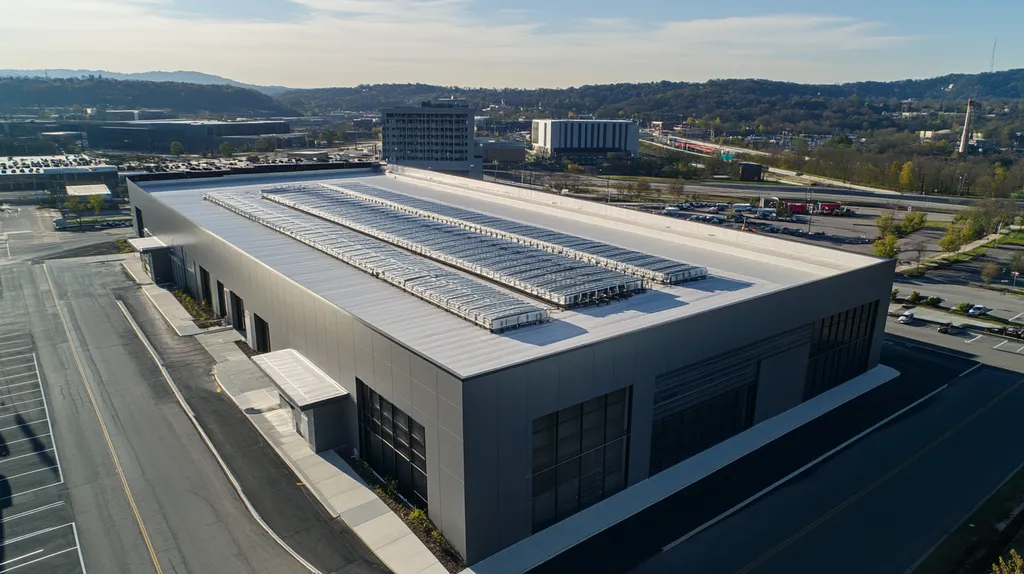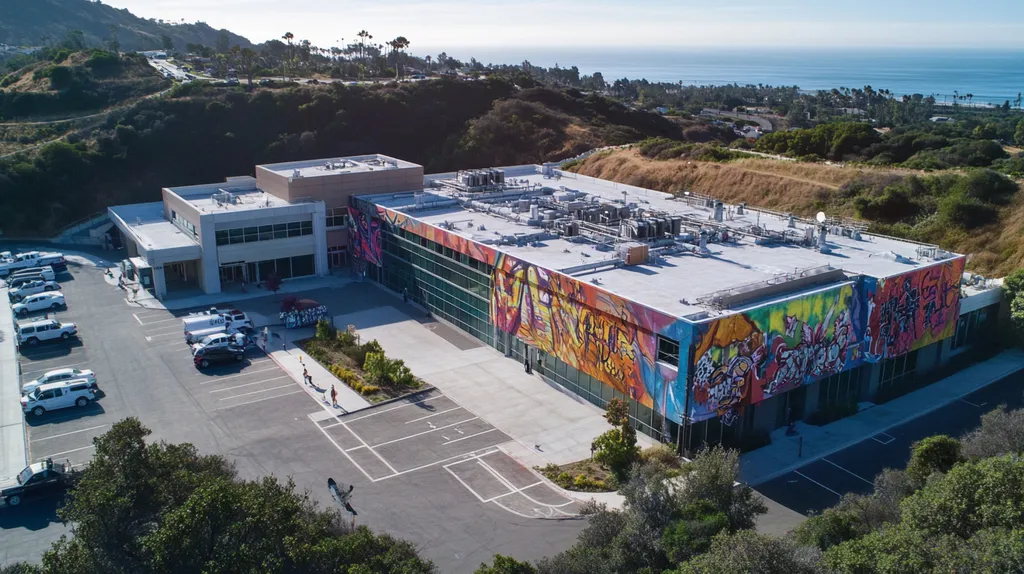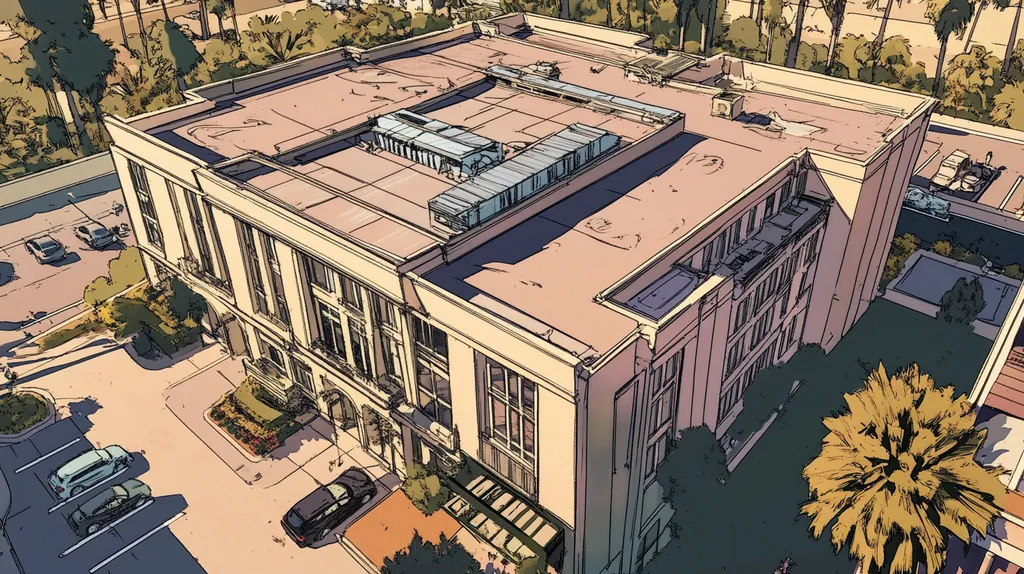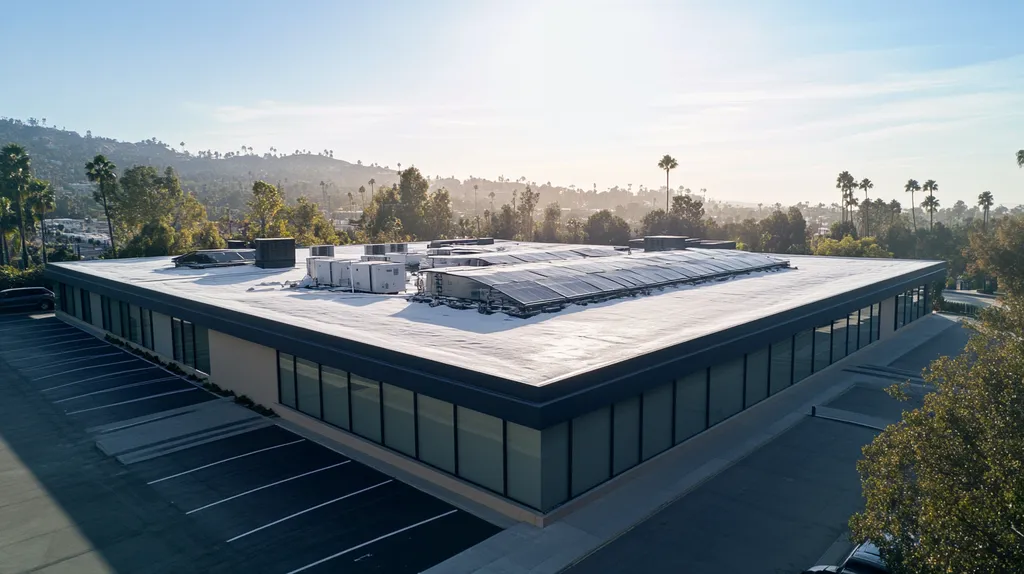For commercial property owners, the ticking clock of an aging roof isn’t just a maintenance concern—it’s a potential financial time bomb. With over 70% of commercial roofs approaching or exceeding their intended lifespan, understanding insurance coverage limitations has never been more critical.
From unexpected repair costs to denied claims, the consequences of overlooking these restrictions can devastate bottom lines. Many owners discover too late that their aging roofs carry severely reduced coverage or sky-high deductibles.
This comprehensive guide breaks down everything property owners need to know about coverage limitations for older commercial roofs, from basic terminology to practical solutions that protect their investments.
SECTION 1: THE BASICS EXPLAINED
For property owners and facility managers, grappling with the limitations on coverage for older commercial roofs isn’t just an exercise in diligence—it’s a necessity. A staggering 30% of older roofs encounter failures that can spark costly repairs and disrupt business operations. By taking a proactive approach to roofing decisions, property owners can save time, money, and a lot of headaches. In this section, we’ll dissect what these coverage limitations entail, their importance for your building, and how they function in practice.
What It Is (In Plain Language)
When we talk about limitations on coverage for older commercial roofs, we refer to the constraints that insurance companies impose as roofs age. By the time roofs hit their typical lifespan of 20 years, insurers typically start tightening the reins, reducing or outright eliminating coverage for damages categorized as wear and tear. This shift can come as an unwelcome surprise for property owners, many of whom may be oblivious to these significant changes in their policies.
Older roofs often come with increased deductibles or elevated premiums, as insurers flag them as high-risk due to factors such as material degradation and greater susceptibility to leaks. Being well-versed in these terms isn’t just a bureaucratic triviality; it equips property owners to make informed decisions about maintenance and insurance coverage.
If a roof fails and coverage is lacking, the financial hit can be severe. Property owners could find themselves paying for repairs out of pocket, making awareness of these limitations essential for effective planning. The commercial roofing landscape is intricate, with coverage terms varying widely by insurer, so clear communication with insurance companies is vital for securing adequate protections.
Why It Matters (To Your Building)
The repercussions of coverage limitations can echo throughout a property in unexpected ways. Buildings with aging roofs face financial vulnerabilities that can rear their ugly heads during events like a sudden storm. Damages incurred may translate into repair costs that existing policies won’t cover, landing property owners in hot water.
Moreover, understanding these limitations empowers property owners to prioritize maintenance or consider timely roof replacements. By staying ahead of the game, property owners can sidestep potential coverage issues altogether—securing not only their investment but also their peace of mind.
Insurance coverage does more than shield against physical damage; it serves as a safeguard for financial stability. If an older roof goes unattended, complications could arise such as business interruptions or loss of rental income, potentially jeopardizing a property owner’s financial health.
A comprehensive understanding of roofing warranties and potential claims can also empower property owners during their decision-making processes. This knowledge fosters proactive management of roofing assets, bolstering the sustained health of the building.
How It Works
Insurance policies lay out specific terms for commercial roof coverage, and property owners must scrutinize these details closely. It’s paramount to understand what’s included, particularly concerning age-related limitations. Insurers often demand documentation on the roof’s condition and its maintenance history when claims arise related to older structures.
Claims for older roofs can undergo rigorous scrutiny from insurers. They may delve into evidence of wear and tear, ready to cast doubt on whether damage resulted from a genuine insurable event or from neglect. Such scrutiny can lead to claim denials if the insurer concludes that replacement or repairs should have happened sooner.
Property owners might also consider upgrading their roofs with modern materials or technologies. Such upgrades can not only extend the lifespan of a roof but also lead to improved insurance coverage options. Innovative roofing solutions typically qualify for better insurance terms due to a decrease in risk-related factors.
Ultimately, gaining a better understanding of how coverage operates enables property owners to confidently navigate the insurance maze. By securing robust coverage and making informed maintenance and replacement decisions, they can ensure the longevity and well-being of their investments.
SECTION 2: PRACTICAL APPLICATIONS
For property owners, grasping the limitations on older commercial roofs is not just a good idea—it’s essential. With the potential for leaks, structural damage, and skyrocketing repair costs, the stakes are high. For example, a roof over 20 years old might only enjoy limited insurance coverage, leaving owners to shoulder hefty repair bills. This section will illuminate common scenarios where this knowledge proves vital, the critical moments when roof coverage becomes indispensable, and how aging roofs interact with other building systems.
Common Uses & Examples
Older commercial roofs may still serve important roles, but their efficiency wanes over time. Facilities such as storage warehouses, retail stores, and industrial plants may find their roofs losing comprehensive coverage as they age. Take, for instance, a flat roof over 25 years old; insurers often limit coverage on such structures, increasing the risk of leaks and costly repairs.
Imagine a manufacturing facility with a 30-year-old asphalt roof. The traditional warranty and insurance coverage might no longer apply, leaving the owner financially exposed. Materials like single-ply membranes can deteriorate, resulting in water intrusion and damages.
By understanding how roof age impacts coverage, property owners can make more informed choices about necessary repairs or replacements. A proactive strategy can prevent financial loss and ensure smooth operations.
Ultimately, the type and age of roofing materials play a significant role in both functionality and the associated risks property owners face.
When You Need It Most
Owners of older roofs should maintain a heightened awareness, especially after severe weather events. Following a hailstorm or heavy snowfall, it’s crucial for property owners to assess any potential damage to aging roofs. Delaying inspections can lead to significant complications should water manage to infiltrate the building.
This is particularly critical for businesses under strict timelines and budgets. For example, a retailer facing downtime from a leaky roof during peak season could experience devastating revenue losses. Being aware of coverage limitations allows owners to prioritize timely inspections and repairs.
Additionally, potential financial ramifications arise when filing insurance claims. If an owner hesitates to act after damage occurs, they may forfeit opportunities for compensation. The age and condition of their roof can drive swift action when emergencies strike.
In dire situations, recognizing how aging affects coverage might spell the difference between manageable repairs and overwhelming financial burden.
Interactions With Other Systems
The health of older roofs often intersects with other critical building systems, including HVAC and electrical setups. A compromised roof can lead to moisture infiltration, potentially soaking insulation and straining HVAC appliances, which can drive energy costs skyward. This interconnection highlights the synergy between roofing health and overall efficiency.
Consider a commercial property with aging roofs experiencing mold growth—this not only compromises indoor air quality but can also pose serious health risks. Overlooking these interactions may lead to tenant dissatisfaction, and worse yet, potential legal liabilities.
Moreover, the integration of roofing systems with solar panels is on the rise. However, older roofs may lack the necessary structural support for such upgrades, limiting options for enhancing energy efficiency.
Ultimately, acknowledging how roof aging influences interactions with various systems helps property owners optimize their buildings while mitigating unnecessary risks.
SECTION 3: KEY TERMINOLOGY DECODED
Understanding commercial roofing terminology isn’t just helpful—it’s essential for navigating the insurance landscape with confidence. With around 80% of commercial roofs in the U.S. aging beyond 15 years, misconceptions about coverage can lead property owners down a perilous path. Mastering the lingo enables sharper decision-making, ultimately safeguarding valuable investments from unexpected pitfalls.
Essential Terms Explained
Terms like “aged roof” and “current market value” can significantly influence coverage options. An aged roof generally refers to roofs that are over 15 years old, often leading to decreased insurance compensation. Knowing your roof’s current market value can empower owners to negotiate better insurance terms and avoid underinsurance traps.
Another crucial term is “replacement cost value (RCV).” This figure represents what it would take to replace a roof post-loss, factoring in depreciation. A roof’s age and material type can drastically affect its RCV, making it indispensable for property owners to clarify this early when establishing coverage.
Let’s also not overlook “actual cash value (ACV).” This term considers depreciation, meaning owners of older roofs may find payouts falling short of their expectations. Grasping these key terms will lead to informed choices that directly impact financial outcomes.
Industry Jargon Translated
The roofing industry is a minefield of jargon that can often leave property owners scratching their heads. Terms like “drainage slope” and “membrane” may sound intimidating but are vital for grasping roof performance. The drainage slope refers to the angle designed to channel water away, while membrane pertains to the protective layer atop flat roofs.
Understanding “warranties” and “service life” can steer decisions towards better outcomes. A warranty varies by materials and usually covers specific issues for designated time frames. The service life indicates how long a roof is anticipated to function optimally, which directly impacts maintenance and insurance coverage options.
Translating this jargon equips property owners to communicate effectively with roofing professionals and insurance agents. With this vocabulary in their toolkit, property owners can ask the right questions regarding their coverage limitations and make informed decisions.
Measurement & Units Simplified
Navigating measurements in roofing can feel like deciphering an alien language, but understanding these terms is key to protecting investments. The most common measurement for flat roofs is a “square,” which covers 100 square feet. Knowing how to calculate square footage is essential for accurate estimates regarding repairs or replacements.
Another fundamental metric is the “pitch” of a roof, referring to its slope or steepness. A proper pitch is crucial for effective drainage and can impact warranty conditions. Most commercial roofs should have a specific pitch to ensure snow and rain are shed efficiently, or else moisture retention can lead to costly damage over time.
Moreover, understanding terms like “gauge” is critical when discussing roofing materials. Gauge measures the thickness of metal used; opting for thinner metal may save money initially but can lead to higher maintenance costs later. Familiarity with these measurements can significantly reshape long-term roofing expenses and ultimately safeguard investments.
SECTION 4: DECISION FACTORS
For property owners, understanding the limitations on coverage regarding older commercial roofs is more than just an academic exercise—it’s a crucial strategy to avoid unexpected financial pitfalls. With nearly 70% of commercial roofs in the U.S. surpassing the 20-year mark, underinsurance and misinformed decisions can quickly lead to costly surprises. This unveiling of critical decision factors—cost, performance, and durability—provides essential clarity for making informed choices about roofing investments.
Cost Considerations
Cost is often front and center when evaluating older roofs. Their advanced age typically ushers in escalating repair and maintenance expenses, creating a classic dilemma for property owners: should they patch up the sinking ship or invest heavily in a costly new vessel? Ignoring these aging roofs may mean higher insurance premiums, as they become prime candidates for claims.
It’s also essential to recognize that many insurance policies impose strict limits on older roofs, bumping up deductibles or scaling back on comprehensive protection. In plain English, when damage occurs, property owners might be left grappling with substantial out-of-pocket expenses.
As you analyze options, comparing the costs of maintaining an older roof against the potential long-term savings from a new installation becomes paramount. In some scenarios, the financial benefits of reduced repair costs and improved coverage can far outweigh the initial investment.
Ultimately, property owners must balance immediate operational costs with the overall financial health of their buildings. A thorough cost analysis can steer clear of miscalculations that could result in inadequate coverage or unnecessary expenditures.
Performance Trade-offs
Older roofs typically lag behind their modern counterparts in performance, posing challenges to energy efficiency and overall sustainability. As roofing technology advances, new materials boast enhanced durability and insulation characteristics. This begs the question: Is it worth holding onto an aging roof when a more efficient system is beckoning?
For example, consider traditional built-up roofs. They often provide less thermal insulation compared to contemporary single-ply membranes, leading to elevated energy costs and reduced tenant comfort—which can, in turn, impact tenant satisfaction and retention.
Moreover, if aging roofs fail to meet current performance standards, property owners might find themselves struggling with insurance coverage. Insurers may require upgrades to align roofs with modern best practices, necessitating an evaluation of long-term performance needs that can leave owners in a bind.
Ultimately, deciding whether to keep an old roof or spring for an upgrade hinges on an assessment of operational efficiency and regulatory compliance. Performance ought to remain a pivotal consideration in every roofing decision.
Lifespan & Durability Factors
The lifespan of an older roof often pales in comparison to that of contemporary materials, raising red flags about long-term reliability. Conventional roofing systems might only last 15-20 years, creating significant uncertainty for owners eyeing future planning.
As roofs age, their durability wanes due to relentless environmental exposure and general wear. This deterioration can lead to increasing susceptibility to leaks, thermal expansion cracks, and other damage-inducing maladies—resulting in costly repairs and inflated claims that weigh heavily on premiums and property value.
Property owners need to thoroughly consider the repercussions of operating beneath a worn roof. This includes potential disruptions to business operations that could hinder financial profitability. Investing in a new roofing system might not only extend the roof’s lifespan but could also enhance the building’s market appeal.
In short, evaluating a roof’s lifespan and durability is paramount. Owners should prioritize this assessment, as it significantly influences operational functionality, market positioning, and coverage prospects.
SECTION 5: COMMON CHALLENGES
As commercial roofs reach their golden years, they often confront a series of formidable challenges that can threaten property integrity and disrupt operations. Consider this: more than 60% of commercial roofs are over 20 years old and frequently encounter issues like leaks and material degradation. For property owners, understanding these challenges is vital—not just for protecting investments but also for ensuring safety and continuity of business.
Frequent Problems & Solutions
Older commercial roofs often face a trifecta of troubles: ponding water, pesky leaks, and material deterioration. Ponding water can wreak havoc, threatening structural integrity. The solution? Ensure adequate drainage systems are in place to prevent water from pooling.
Leaks can be another significant headache, typically stemming from worn seams or flashings. Regular inspections and prompt repairs can nip leak-related issues in the bud, preventing them from ballooning into major repair bills.
Then there’s the roofing membrane itself, which can deteriorate over time due to relentless UV exposure and atmospheric wear. To combat this, property owners might consider applying reflective coatings or rejuvenating products—think of them as sunscreen for roofs, extending lifespan while boosting energy efficiency.
Implementing a proactive maintenance plan is essential. Regular inspections by qualified roofing professionals can identify potential issues early, ultimately saving time and money.
Warning Signs To Watch For
Property owners must be vigilant about specific warning signs that signal an aging roof. Common indicators include visible sagging, water stains on interior ceilings, and loose or missing shingles.
A sagging roof often indicates structural deficiencies that require immediate attention, while those unsightly water stains could mean leaks are already at work, necessitating urgent repairs.
Other red flags include blistering or cracking of roofing materials, which can expose insulation to moisture, causing energy costs to spike. Regular inspections are crucial; dedicating time to spot these issues early can save a world of trouble down the line.
Documenting inspections every six months not only helps track changes but also aids in prioritizing repairs before minor concerns escalate into larger problems.
Preventative Approaches
Adopting a preventative maintenance strategy is key to extending the life of an older roof. Establishing a regular inspection schedule allows property owners to identify issues early and address them before they transform into costly repairs.
Annual sealing of seams and flashings can significantly reduce the likelihood of leaks. Additionally, keeping roof areas clear of debris is essential, as it prevents water ponding and mitigates the risk of structural damage.
Investing in professional assessments can provide invaluable insights into the roof’s overall condition. This process paves the way for tailored maintenance plans that effectively target the specific vulnerabilities of older roofing systems.
Lastly, providing comprehensive training for staff on roof management can ensure that everyone is on the lookout for warning signs and knows when to enlist professional help, further safeguarding the property from roofing challenges.
SECTION 6: NEXT STEPS & RESOURCES
As the complexities of older commercial roofs become clearer, property owners face a pressing need to act. With nearly 60% of property claims stemming from roofing troubles, understanding coverage limitations for aging roofs is vital for protecting investments. This section serves as a roadmap, highlighting crucial questions to raise with coverage providers, essential industry standards to adhere to, and valuable resources for ongoing education that empower informed decisions.
Questions To Ask Providers
When engaging with insurance providers, clarity is essential. Property owners should ask specific questions about exclusions related to roof age and how these affect coverage limits for aging structures. Understanding these nuances can be the difference between a sturdy safety net and a gaping hole in protection.
Property owners should also explore the details of replacement versus repair costs. Insurance coverage for older roofs may differ significantly from that of newer materials, making it imperative to clarify these distinctions upfront to avoid unpleasant surprises later.
Additionally, insurance requirements for maintenance often come with a fine print. Insurers may mandate regular inspections to keep coverage valid. Knowing these maintenance requirements before filing a claim can save considerable headaches in the future.
Finally, don’t shy away from discussing deductibles and potential limits. While higher deductibles can lower premiums, they can also translate into steeper out-of-pocket expenses when it’s time to make repairs.
Industry Standards & Guidelines
Being well-versed in industry standards is crucial for every commercial roof owner. Organizations like the National Roofing Contractors Association (NRCA) offer guidelines that shape coverage options. Knowledge of these standards can significantly impact insurance considerations.
These guidelines cover best practices for installation, maintenance, and repair, all of which reflect directly on insurance expectations. Following these industry protocols not only promotes roof longevity but also enhances the likelihood of favorable coverage.
A roof not maintained according to these established benchmarks may face reduced claims allowances. Compliance can mean the difference between securing full restoration and facing hefty out-of-pocket costs.
As standards continue to evolve, staying informed about the latest developments can help property owners align with best practices, thereby enhancing their insurance scenarios.
Further Learning Simplified
To deepen understanding of older commercial roofs and their coverage limitations, various educational resources are available. Webinars led by industry experts often break down complex roofing topics into actionable insights, making it easier for property owners to stay informed.
Online platforms, such as the American Society of Civil Engineers, provide an array of educational articles and videos tailored to roofing issues, especially those that concern older structures.
Trade shows and local workshops serve as excellent venues for live interaction. These events present opportunities for property owners to connect directly with manufacturers, contractors, and insurance providers, fostering informed relationships.
Finally, subscribing to industry publications and newsletters ensures property owners keep pace with emerging trends and regulatory changes, solidifying a proactive approach to their roofing investments.
The Bottom Line
With over 70% of commercial roofs approaching their coverage limits due to age, property owners can’t afford to remain in the dark about insurance restrictions.
The financial stakes are severe: a single uncovered repair on an aging roof can cost upwards of $50,000, while complete replacement could exceed $250,000.
Understanding coverage limitations isn’t just about avoiding surprises – it’s about protecting business continuity and asset value.
Property owners must act now to evaluate their aging roofs, review their coverage details, and develop strategic maintenance plans.
The difference between proactive management and reactive scrambling could mean the difference between a minor setback and a devastating financial blow.
FREQUENTLY ASKED QUESTIONS
Q. What are the limitations on commercial roof coverage for older buildings?
A. As roofs age, typically over 20 years, insurance coverage often diminishes. Insurers may increase deductibles, reduce claims, or eliminate coverage for wear and tear. Being aware of these limitations is crucial for your financial planning.
Q. When is commercial roof coverage most critical after severe weather?
A. After severe storms, it’s vital to assess any potential roof damage immediately. Delays can lead to worsening conditions, potentially jeopardizing exposure and triggering substantial repair costs that might fall outside your coverage.
Q. What are key terms in commercial roof insurance I should know?
A. Important terms include “aged roof,” which refers to roofs over 15 years, and “replacement cost value,” which defines compensation for replacing the roof post-loss. Understanding these terms helps navigate coverage limitations effectively.
Q. How do cost factors influence commercial roof decisions?
A. Cost pertains to repair and maintenance expenses that can increase as roofs age. Making informed decisions around repairs versus replacements can directly impact your insurance premiums and potential out-of-pocket costs.
Q. What are common challenges for older commercial roofs?
A. Common challenges include leaks, material deterioration, and ponding water, all of which can threaten structural integrity. Implementing regular inspections and maintenance can mitigate these issues and enhance the roof’s lifespan.
Q. What questions should I ask my insurance provider regarding roofing coverage?
A. Ask specific questions about exclusions related to roof age, how these affect coverage limits for aging structures, and what maintenance records might be necessary to maintain your coverage.
Q. How can I further educate myself about commercial roof insurance?
A. Enroll in webinars, subscribe to industry publications, and attend local workshops. These resources can provide valuable insights about roofing issues and help stay informed on best practices and regulatory changes.











